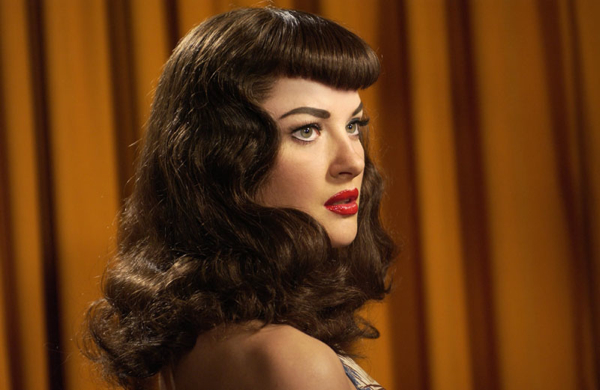Movie review by Greg Carlson
Tame and tepid when it should be provocative and electrifying, “The Notorious Bettie Page” turns out to be just another dreadfully dull, fill-in-the-blanks biopic. Deliberately choosing a tone, style, and point of view that conspire to hold the title character at a psychological and emotional distance, director Mary Harron falls far short of the success she had with her clever adaptation of “American Psycho.” Working again with Guinevere Turner as co-screenwriter, Harron glides along on the surface, adamantly refusing to speculate about Bettie Page the person.
To her legion of admirers Page was the ultimate 1950s pin-up model. With her dazzling smile, signature brunette bangs, and uninhibited enthusiasm for posing, Page virtually defined the look of an era. Projecting a joyful personality, Page worked with a complete absence of anything resembling a sense of shame, probably the single-most cited reason for her transcendent popularity. Following her retirement from modeling in the late 1950s, Page disappeared from the public eye. Her silence only fueled interest and enthusiastic collectors continued to buy, sell, and trade all manner of Page memorabilia.
It is possible that some Page fanatics will be perfectly satisfied with Harron’s decision to portray Bettie as a blank slate, but most audience members would surely prefer to see the central character as a real person with a vivid inner dimension. As Page, Gretchen Mol is well-cast, but the talented performer cannot overcome the script’s almost total lack of definition. From nearly start to finish, Page seems content to bob along from one episode to the next, almost always at the suggestion of unknown men.
To the film’s credit, John Dunn’s meticulous costume design recreates literally dozens of Page’s outfits, from her own hand-sewn bikinis to the elaborate fetish corsets and footwear that accompanied her work for brother and sister photography team Irving and Paula Klaw (Chris Bauer and Lili Taylor). The movie is at its most lighthearted and watchable during the restaged photo shoots, which range from the early amateur camera club sessions to the complex rope bondage scenarios favored by the Klaw’s loyal customers. Particularly effective are several lush color sequences that vibrantly capture the nostalgic flavor of the post-World War II era.
Harron never offers viewers a hint about Bettie’s emotional needs, opting instead to saddle the character with a naiveté that would seem to contradict Page’s intelligence and drive. Like so many biopics, “The Notorious Bettie Page” skips over huge sections of the subject’s life, gliding past a number of significant relationships. Art Amsie, generally acknowledged as one of the key Page photographers of the camera club years, is reduced to vapor. Page’s collaboration with Bunny Yeager is treated with maddening superficiality. Even Page’s religious awakening functions as a thematic sin-versus-redemption device that grossly oversimplifies Page’s spirituality by suggesting a single reason for her decision to leave modeling. “The Notorious Bettie Page” might earn some new converts to the Page cult on the strength of Mol’s impression, but for a film dealing with the struggle between 1950s repression and sexuality, Harron’s movie is a major disappointment.
